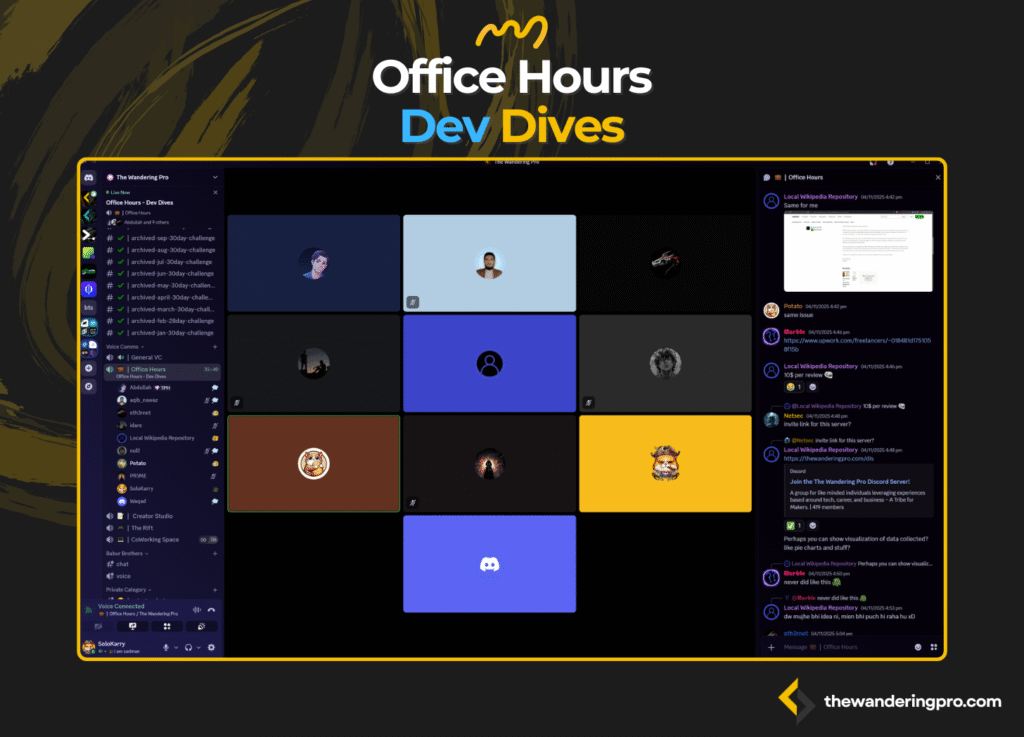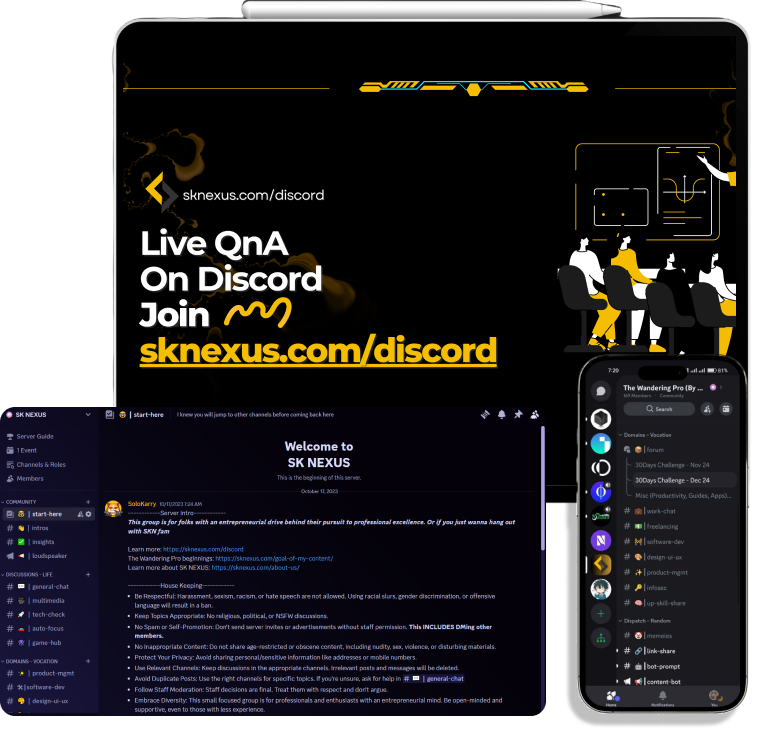
Frameworks, Backend Careers, and Pivoting in Tech
The Wandering Pro Dev Dives Session Recap
The latest The Wandering Pro Developer Session covered a wide range of topics, from backend career growth and framework performance to transitioning between technical domains. The session was led by Bahroze, a senior software engineer with over five years of experience in the MERN stack, currently working with Next.js, Prisma ORM, and PostgreSQL.
Early Career Guidance for Developers
A new participant, introduced himself as a first-year university student interested in backend development.
The hosts explained that backend work involves more than just API creation – it includes system design, scalability, and performance optimization.
He advised students to use summer breaks for internships to gain exposure to real product environments. Agencies can help with short-term experience, but product companies offer deeper learning through long-term system maintenance and problem-solving.
According to the hosts, there is no “bad” tech stack; languages and frameworks are tools built to solve specific problems. They added that Java remains common in enterprise-level systems due to its concurrency handling and stability, while Node.js is often used for faster prototyping and smaller-scale products.
For first- and second-year students, they emphasized focusing on data structures and algorithms, as these foundational skills apply to all programming languages and domains.
Product vs. Service Companies in Pakistan
The discussion moved to the distinction between product-based and service-based companies.
The hosts clarified that Pakistan’s software industry is primarily service-oriented, but not all service companies are the same.
Some agencies develop platform-level or multi-user products for external clients, offering experiences similar to product companies.
He suggested developers look for roles involving complex systems or live user environments, as these provide the strongest learning curve.
For new developers, the focus should be on learning opportunities rather than immediate financial gain. Choosing an environment that offers technical challenges leads to better long-term growth.
Technical Discussion: Frameworks and Performance
Later, the session shifted to technical topics, particularly around Next.js, React, 10Stack, and Flutter web.
Participants discussed common frontend issues such as large JavaScript bundle sizes, long load times, and state management inefficiencies.
The hosts explained that Next.js offers server-side rendering (SSR) and server functions to improve performance, but still requires client-side components for stateful interactions such as sorting or filtering.
He pointed out that Next.js and React both continue to mature, with new features such as caching, routing, and server actions improving over time. However, code maintainability remains a challenge – as more features are added, managing and optimizing code becomes harder.
Regarding Flutter web, the hosts and participants noted that it remains slower than mobile implementations due to heavy JavaScript compilation and unoptimized API handling. Flutter is stable for mobile app development but not yet mature for web use.
Memoization and Optimization
The group also discussed memoization, a technique used to prevent unnecessary re-renders in React and Flutter.
The hosts explained how memoization helps reduce performance overhead by skipping re-renders when component values do not change.
Using browser DevTools, developers can analyze render cycles, state updates, and component performance at a millisecond level.
Proper use of memoization and callbacks can significantly improve frontend responsiveness but may also increase CPU cost if used excessively.
UI Design: Flutter vs Web Frameworks
Participants compared Flutter’s UI structure with traditional web frameworks.
Flutter’s row-and-column layout was highlighted as easier for visualizing and stacking UI components.
The hosts noted that while HTML and React grids can achieve similar results, Flutter’s structure makes layout management more intuitive.
React vs Next.js for Web Applications
A question was raised regarding whether React or Next.js should be used for building admin dashboards with a Python backend.
The hosts explained that the choice depends on priorities – whether the goal is to build quickly or build with long-term maintainability.
He mentioned that Next.js gained popularity due to its SSR features and built-in routing but involves more complexity and dependency management.
React, on the other hand, offers more flexibility and simpler code maintenance for smaller projects.
He summarized that framework selection should depend on the project’s scalability requirements, code quality goals, and developer familiarity, as both technologies continue to evolve.
Career Pivot: From Web Development to Data Science
A participant asked about transitioning from full-stack web development to data science.
The hosts explained that data science is a broad domain, including data analytics, AI, machine learning, and web scraping.
To make a successful pivot, they advised building data-focused projects – for example, using tools such as Apache Spark, Microsoft Power BI, or big data processing frameworks – and showcasing them in a portfolio or resume.
Web development experience can still be valuable if it’s presented as practical software experience. Over time, working on domain-specific projects helps establish credibility in the new field.
Transitioning Between Roles Inside a Company
The discussion also covered internal pivots within tech roles.
The hosts shared examples of moving from backend to frontend work within a company by collaborating with other developers and gradually taking on cross-functional tasks.
He advised participants to observe how teams handle backend or frontend development and offer to assist with small features.
Over time, this helps build full-stack experience and improves understanding of complete product workflows.
For teams using Firebase or Amplify as backend services, they recommended learning cloud functions and API integrations to bridge the gap between backend and frontend roles.
Closing Notes
The session concluded with a discussion on workplace realities for new developers.
The hosts cautioned that some companies may underpay or assign limited roles to fresh graduates without technical exposure.
To avoid this, they suggested creating personal projects (for example, via roadmap.sh) to strengthen practical skills and demonstrate execution ability.
He also reiterated that joining product-based environments or hybrid service-product companies offers stronger learning experiences than short-term agency work.
Key Takeaways
- Focus on foundational skills such as algorithms, data structures, and debugging.
- Gain early experience through internships or real-world projects.
- Framework choice should depend on project goals and team maturity.
- Next.js is optimized for SSR; React remains simpler for maintainable code.
- Flutter is stable for mobile but still maturing for web.
- Pivoting into new domains requires domain-specific projects and portfolio updates.
- Collaboration within teams can help transition between frontend and backend roles.
- Product-oriented environments provide deeper technical learning than short-cycle projects.


Hey, I’m Bahroze, I specialize in helping startups build and launch MVPs, making sure you get your customers/clients onboarded fast. My approach mixes tech expertise with startup knowledge, making it easy to work with any tech stack. When I’m not coding, you’ll find me traveling, gaming, or listening to podcasts.


